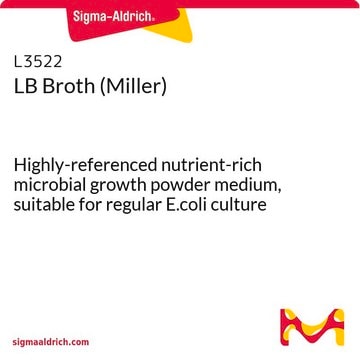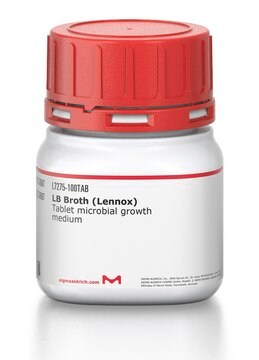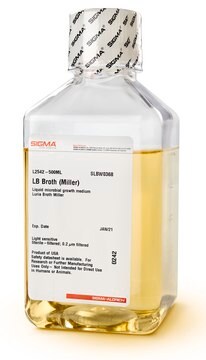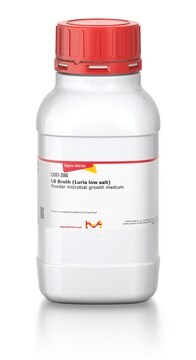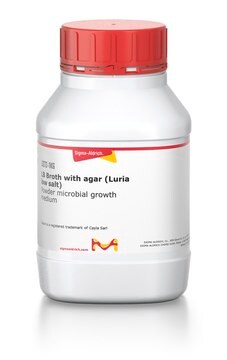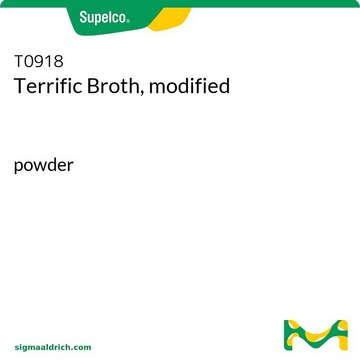Wichtige Dokumente
L7658
LB-Bouillon
EZMix powder microbial growth medium
Synonym(e):
Lennox broth
About This Item
Empfohlene Produkte
Qualität
for molecular biology
Qualitätsniveau
Beschreibung
quick-dissolve, dust-free formulation
Sterilität
non-sterile
Form
powder
Methode(n)
microbiological culture: suitable
pH-Wert
6.8-7.2(2.5% solution)
Anwendung(en)
agriculture
food and beverages
microbiology
Lagertemp.
room temp
Eignung
nonselective for Escherichia coli
nonselective for coliforms
Allgemeine Beschreibung
Anwendung
Leistungsmerkmale und Vorteile
- Granulated, dust-free format for safer handling and faster mixing
- Convenient small package to eliminate weighing
- Easy scale-up using larger package sizes
- Standard formulation
Komponenten
10g/L Tryptone
5 g/L Yeast Extract
5 g/L NaCl
0.6 g/L inert binder (EZMix formulation only)
Angaben zur Herstellung
2. Autoclave for 15 minutes at 121 °C.
To prepare Lennox L Broth: Add 1 g glucose and proceed with preparation instructions as above.
To prepare the medium of Enquist and Sternberg: Aseptically add 10 ml of sterile 1M magnesium sulfate after autoclaving.
Rekonstituierung
Rechtliche Hinweise
Ähnliches Produkt
Lagerklassenschlüssel
11 - Combustible Solids
WGK
WGK 2
Flammpunkt (°F)
Not applicable
Flammpunkt (°C)
Not applicable
Analysenzertifikate (COA)
Suchen Sie nach Analysenzertifikate (COA), indem Sie die Lot-/Chargennummer des Produkts eingeben. Lot- und Chargennummern sind auf dem Produktetikett hinter den Wörtern ‘Lot’ oder ‘Batch’ (Lot oder Charge) zu finden.
Besitzen Sie dieses Produkt bereits?
In der Dokumentenbibliothek finden Sie die Dokumentation zu den Produkten, die Sie kürzlich erworben haben.
Kunden haben sich ebenfalls angesehen
Protokolle
General protocols for growth of competent cells in microbial medium.
Unser Team von Wissenschaftlern verfügt über Erfahrung in allen Forschungsbereichen einschließlich Life Science, Materialwissenschaften, chemischer Synthese, Chromatographie, Analytik und vielen mehr..
Setzen Sie sich mit dem technischen Dienst in Verbindung.
